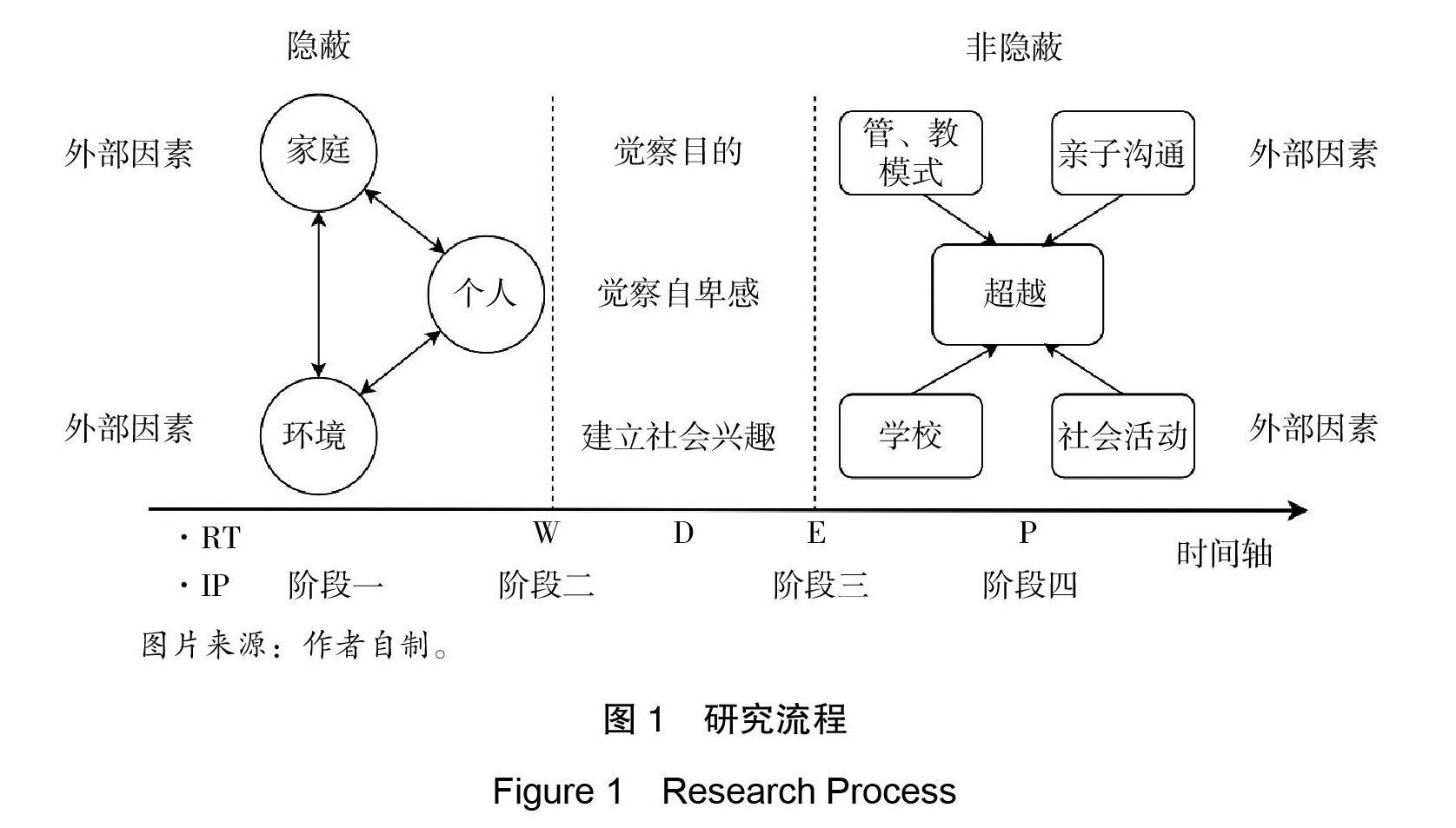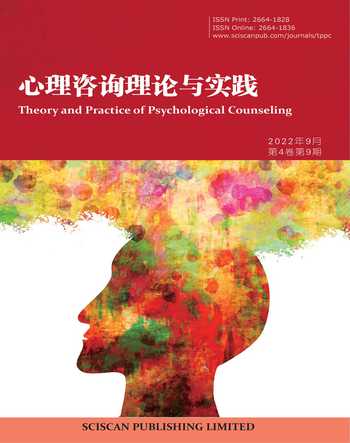阿德勒心理学结合现实治疗法在澳门隐蔽青少年中的应用
余秋 蔡远宁

摘 要|本研究旨在探讨阿德勒心理学结合现实治疗法对隐蔽青少年的应用。在此基础上,本文提出“隐蔽”与“偏差行为”两者间的关系,且都是经由个人、家庭与环境三个方面影响而形成的。并以阿德勒心理学的三个核心主题来探讨青少年的隐蔽现象,分别是自卑与超越、目的论、社会兴趣。个人方面提出觉察自卑感与责任感,是能帮助个体超越自卑,脱离隐蔽。家庭则以目的论为观点, 以协助家长觉察自身与孩子的目的与需求,透过改变管教技巧重建亲子关系。而环境方面则强调培养社会兴趣的重要,以推动青少年参与社会活动,发掘出自身优势连结社会。因此,阿德勒心理学与现实治疗法结合的介入方案,能有效协助青少年脱离隐蔽重返社会。
关键词|隐蔽青少年;阿德勒心理学;现实治疗法;同化整合
1 引言
隐蔽是现今的社会现象[1],自 1999 年以来,有大量研究指出青少年“双待 / 隐蔽”(not in education,employment and training,NEET)是反映现今社会 家庭过度溺爱孩子的情况,是个体为逃避人际情境,不愿意与社会互动而产生 的生理与心理反应[2-5],且会进一步影响个体情绪而产生偏差行为出现[6]。因此, 在童年至成年的阶段正是青少年生理与心理转型及统合的关键时期[7],若辅以 心理辅导及系统支持的方式进行介入,引导其对社会重新连结,能有效减低其 “隐蔽”的程度[8,9]。
然而,早在 20 世纪初,阿德勒已就“隐蔽”相关议题提出论述,认为这些都是与个人目标、家庭及同侪关系不佳有所关联[10-12]。且以阿德勒心理学,又称个体心理学(individual psychology,IP)理论来解释这种现象,其核心观点主要包含三个方面:第一,自卑与超越,认为人的自卑感是一种补偿作用,是个体进步与成长的内部驱力,也是成功的关键因素。换言之,人在自卑时会发挥潜能, 追求卓越[10,13-15]。第二,目的论是强调选择与责任,认为人的行为与情绪是带有目的性,且任何时候人都有选择的权利,更需要为自身的行为负责[16,17]。 换句话说,人能通过改变想法与行为继而改变感受,以致课题分离,重新选择生活。这也是现实治疗法(reality therapy,RT)的核心概念。第三,社会兴趣, 强调归属感、社会连结与贡献他人,并认为人是社会性的,拥有高社会兴趣, 其心理会较健康[11,17]。而不同研究也指出社会兴趣对个人心理、适应力及偏 差行为有所关联[18-21]。
总的来看,IP 理论的三个面向是强调想法、选择与责任。表示人能以正向积极的观念带来转变,且在任何时候都可通过选择,过自己想过的生活形态, 并藉由超越自卑感,发展出社会兴趣而贡献他人,是现今正向心理学、认知学派、人本主义等理念的基础[22-24]。但其概念较倾向于意象学及人民主义方向,故其量度方式一直受到质疑,且每个理论都有其优劣之处,也没有一种疗法可以有 效解决所有个案的问题[25,26]。因此近年有学者发现,运用同化整合(assimilative integration)模式协助求助者带来转变的效果更为显著[27,28],当中,更证实了 IP 与 RT 两者的兼容性。换言之,以 IP 与 RT 相混合的同化整合模式能有效让求助者带来转变。但是,过往进行有关同化整合的研究一般以外国居多,且大 多关注精神疾患方面,应用于隐蔽青少年方面较少。基于此,本研究将以 IP 观点就个体、家庭来进行干预及介入,检视当事人在隐蔽中所面对的问题,分别就以下两方面进行探讨:(1)探讨阿德勒心理学在隐蔽青少年的个案成效;
(2) 结合现实治疗法和阿德勒心理学对隐蔽青少年的效果。就结果成效供学校体系辅导人员作参考,并为日后此方面的研究提出建议。
2 青少年“双待”与“隐蔽”的现况与分析
“双待”最早由英国的消除社会孤立组 Social Exclusion Unit 报告提出,意指 16 ~ 18 岁的非在学、非就业及没有参与任何培训活动的青少年[2]。然而, 这个时期正是童年与成年之间的一个重要过程,是生理与心理的转型与统合, 是人生发展的关键时期[7,29]。在不同国家或地区对此社会现象的定义亦有所不同, 在日本“NEET”又称“茧居族”(Hikikomori)是社会退缩(social withdrawal) 的社交心理现象,反映青少年在家庭溺爱下成长并拒绝出门,是一种为逃避人 际情境及不愿意与社会互动的反应[29,30]。且经由个人、家庭、学校与环境四 个层面所影响:(1)个人层面与自我效能感低、自卑感及对他人的信任感有 关[31,32];(2)家庭层面,与父母的期望、管教方式有关[33];(3)学校层面, 与是否读书、同侪的接纳度,以及学校的成功经验有关[34];(4)环境层面是 与个体的社会连结及社会价值观有关[35]。
香港及澳门则有另一个名词——“隐蔽”来解释这种情况[36,37]。据澳门 数据显示,在 12 ~ 24 岁,且最少三个月留在家中“不参与”或“间断参与” 社会活动(如在学、就业、兴趣班等)的青少年,并依照其外在系统(小区、 学校、工作、朋辈),及内在系统(家庭)的联系程度而划分为三级:(1)“隐蔽”意指青少年在非在学及非就业的状态下,持续超过三个月留在家中,且与外在 系统没有联系,但仍与内在系统有所联系;(2)可能潜在隐蔽意指青少年在非在学及非就业的状态下,与外在系统或内在系统作有限联系。这反映他们与学校、工作或朋辈以间断及逐渐抽离的方式联络,以及与网友、家人作有限度的交流;
(3) 非隐蔽意指青少年有在学或就业的状态[37]。
近年,我国的香港与邻近地区(日本、韩国)青少年的“隐蔽”有持续上升的趋势[38-40],并对青少年的生理与心理带来负面影响[41,42,5]。而香港则每20 位青少年便有 1 位有“隐蔽”的情况,占青年人口的 5%[43],且会使他们进一步引发自卑及偏差行为,如辍学、暴怒、自残、攻击性行为等[44-46]。综上,“隐蔽”一般发生于童年与成年之间,是一种社会退缩现象。是受个人、家庭及环 境所影响,也是青少年出现偏差行为的因素之一,而且都离不开个人的生理与 心理反应,以及内、外系统这两个部分。基于不同背景与地区其定义不同的关系, 故本研究将以澳门定义中对个人的影响方向进行探讨。
2.1 隐蔽青少年的偏差行为
偏差行为的概念,最早由莱默特(Lemert)于 1951 年提出[47],是指人一生会不断发生不同程度的偏差行为,而“隐蔽”是一种社会性的偏差行为。其后,不同学者亦就此观点展开研究,并进一步把偏差行为归纳为受四种因素所影响,分别是个人、学校、家庭及社会因素[48-51]。且发现是人类身体及智力发展的过渡时期,其偏差行为一般发生在 10 ~ 20 岁这个阶段,与青少年成长有密切关系[52,53]。但这些都是一个相对性且复杂的概念,会因应时间、地区或情景的差异而有所不同[54-58]。
心理学则以个人因素观点解释偏差行为,是偏离社会心理和道德规范[59], 一般是指个人违反社会准则、社会规范及身份角色的行为,是个人在环境中遭 遇困难,无法以自身能力及经验去克服而产生的反应[60]。可划分为“行为”与“情绪”两个部分。外向行为问题,意指违反社会规范,未能遵循角色身份的个人行为, 如逃学 / 辍学、不守规条、撒谎、偷窃、伤害别人、破坏等。内向行为问题,意指情绪困扰问题而产生的行为反应,如退缩、自卑、恐惧、躲避群体(离群索居)、冷漠、固执等。
近年有研究发现,亲子沟通、管教与青少年偏差行为的关系[61,62],而责 任感及自我觉察是能有效调适偏差行为[63]。RT 在应用于青少年偏差行为具正向影响,其作用是引导青少年察觉问题与克服困难[64,65],从而提升其自我效 能感、归属感与认同感,接受挑战降低“隐蔽”的程度。综上,青少年偏差行为都离不开个体“行为”及“情绪”,且有大量研究指出,RT 能有效地干预偏差行为,协助青少年面对问题及现实。故本文研究青少年的偏差行为将会从心理学观点出发,探讨个人无法适应环境而产生的反应。
2.2 现实治疗法与同化整合模式
格拉瑟(Glasser)的 RT 是处理心理问题与偏差行为的一种辅导及心理治疗技术,此法不重视“过去”,只着重“现在”,且强调人的行为是有目的性和 意识性,其核心概念是以选择理论为基础,是一种以目的论为出发点的治疗技术。换言之,人是根据内在需求及目标为导向而行动[63,66,67]。并主张透过对话, 以“WDEP”模式协助个案探索需求(want)、理解自身的行动(doing)、继而评估(evaluation)方向,并共同制定及实施计划(plan),从而为求助者带来转 变,是一种重视行动与改变,且快速达到治疗目标的治疗。但由于其疗法只处 理求助者当前行为问题,不强调探索过去、内在需要与社会环境等因素,故此 无法了解求助者在心理方面的挣扎与内在冲突,这也是其局限之处。
然而,梅塞尔(Messer)的同化整合正是突破这种局限,其概念是奠基于一种心理学派取向,同时混以其他心理治疗法进行辅导的实务技术[27,28]。同化整合研究已证实了 IP 与RT 两者间的兼容性[68],即应用 IP 与RT 的治疗,是能协助辅导员从另一视角分析、了解求助者的内在需要,从而共同制定更好的计划[66,69]。
2.3 阿德勒心理学在隐蔽青少年中的应用价值
阿德勒(Adler)提出的 IP 是强调人能以正向积极的观念带来转变,而后继学者也以其观点发展出不同的理论,如自我效能感、选择理论、社会支持理论等[66,70,71]。其目的是协助个体察觉问题、获得领悟,并强调行为背后的目 的是满足其内在需求。当中的核心概念有自卑与超越、目的论及社会兴趣等, 主张人在任何时候都可选择自己的生活状态,并藉由超越自卑感,发展出社会兴趣,从而完成人生任务。此理论指出自卑感是人与生俱来的,是一种有补偿作用的内部驱力,同时也是成功的关键因素[10,14,15,72]。
班杜拉(Bandura)1977 年也认同自卑与追求卓越的动力论观点[73],且结合社会环境因素进一步提出自我效能(self-efficacy)的概念,表示自我效能是 影响个体功能、行为、目标及决定的主要因素,是人至关重要的内部动机。简言之,自我效能感高的人更有可能挑战艰巨的任务,也容易从挫折中恢复过来。而自我效能感低,则常常会回避挑战性的任务[74],且也发现青少年的“隐蔽”与自卑感及自我效能感有着密切的关联[46,75,76]。
除此之外,阿德勒目的论更解释人的行为并非受已发生的因素所影响,而是为了未发生的目的而行动,且要为自己的行为负责[10,17,63]。反映人是可通 过建立目标,改变自身想法与行为,继而改变感受,是一种强调内在控制达成改变的理论。格拉瑟 2000 年的现实治疗法也有同样观点[63],且进一步以医学角度解释为大脑是一个控制系统,个体是为了满足内在需求而产生行动,且人都是可通过转换目标改变思想,从而改变行动与方向[77,78]。这种想法的转换, 对亲职教育有莫大的帮助[79]。
另外,阿德勒认为社会兴趣是人与生俱来,是个体学习与探索自我的平台,是适应环境及心理健康的基础[17]。换言之,人是社会性的,应重视彼此关系与连结, 且实证已表明有高度社会兴趣的人,其心理会更健康[11,17]。柯布(Cobb)1976 年的社会支持理论有同样的观点[80],且结合社会比较概念来解释这一现象,认为社会兴趣是与人建立联系,获得支持与鼓励的一种途径,从而感到关爱、存在价值与归属感,也是个体抗压的保护因素[81,82]。这些都是透过与其他人或团体之间的接触, 获得亲人、同侪的关爱与情绪上的帮助,提升个人的心理健康[83,84]。
综合上述讨论,自卑与自我效能都是人的内部驱力,也是影响个体努力迈 进目标与成功的关键因素,能有助于青少年减少其隐蔽与偏差行为的出现。当 中,确立目标有助于其改变想法,继而作出行动,是一种带来改变的内部驱力。且透过与环境的互动,从社会兴趣中服务他人、贡献社会,使其产生自我效能 感与归属感,从而达到正向补偿作用。而辅导人员如能结合同化整合模式的优势, 将有助于青少年快速达成改变。因此,本研究提出结合 IP 与 RT 的模式进行辅导干预,以降低求助者的隐蔽程度与偏差行为出现,提高其自我效能感与社会 兴趣,从而激发求助者面对现实的动机及驱力。
3 整合模式与理论的应用
本文以科里(Corey)的 IP 四阶段为介入基础[66],协助当事人觉察内在自卑感,并与伍伯丁(Wubbolding)等人 RT 的“WDEP”模型[85],融合应用 IP 与RT 的理论来制定研究流程(见图1),并生成以下四阶段协助当事人获得转变:
阶段一:与当事人建立关系。这阶段辅导员应以聆听、同理当事人为主, 以不批判、不评论、不纠正为原则,也可与当事人谈论一些轻松的主题,以达到快速建立关系的目的。
阶段二:探索当事人的内在驱力。这阶段辅导员仍以聆听、同理为主。辅导员可尝试透过一些生活事件,来引导当事人思考自身需求(want),明白课题分离的作用,即个人需要不一定完全依靠外在而获得,部分是可以源自内在自身。
阶段三:鼓励当事人检视行为与目的距离,及其内在的需要与自卑感觉察,从而达到自卑与超越自我的状态。这阶段辅导员应以引导当事人思考行为背后的目的为首要任务,可透过提问让当事人直视自己的行为,为自身的行为负责。除此之外, 辅导员可透过鼓励当事人作出行动(doing),从而协助其自我评估(evaluation), 这是一个能与当事人共同审视的过程,是协助其迈向下一步的关键。
阶段四:协助当事人重新定向。这个阶段辅导员应以引导、鼓励其行动(doing)、协助评估(evaluation),共同制定计划(plan)与实施。过程中, 辅导员可协助当事人制定一些简单、短期可达成的目标,通过计划和逐步执行, 并以提问方式,引导当事人思考计划的可行性,使其能预见将来成功的自己, 从而推动当事人与社会重新接轨。
4 总结
在应对当今青少年隐蔽现象,辅导员可参照以上的四阶段来进行辅导介入, 并以阿德勒心理学的主题性概念来进行评量,这样便可进一步了解当事人的目前状态与内在需要,以不批判、不评论、不纠正为原则,能有效与当事人快速建立关系。与此同时,现实治疗法的应用能协助青少年减少偏差行为的发生, 使其觉察自身的行为带来的后果,并为自己的行为负责任。除此之外,家庭因素也不容忽视,因为隐蔽的青少年是长期处于家中,并受着家长的管教模式所影响。故此,家长如何理解与孩子的关系尤为重要。而本文提出以目的论来协助家长觉察自身的目的与孩子的需要,是改善亲子沟通的重要基础。另外,友侪关系是推动青少年参与社会活动,发展兴趣与脱离隐蔽的重要因素。最后, 以上为结合阿德勒心理学与现实治疗法的介入应用,是可以有效协助青少年从隐蔽到非隐蔽的转变历程,但要如何协助青少年在重返社会后,不再回归到隐蔽状态,则需要个人、家庭、环境多方面的配合与支持。
参考文献
[1]吕培亮,范重庆,张莹.中国青年群体性隐蔽的审视与思考:基于现象学角度分析[J].当代青年研究,2020,368(5):107-113.
[2]Social Exclusion Unit.Bridging the Gap:New Opportunities for 16-18 Year Olds Not in Education,Employment or Training[M].London:HMSO, 1999:Cm 4405.
[3]Kato T A,Shinfuku N,Sartorius N,et al.Are Japans hikikomori and depression in young people spreading abroad?[J].The Lancet,2011,378
(9796):1070.
[4]American Psychiatric Association.Diagnostic and Statistical Manual of Mental Disorders(Fifth ed.)[M].2013.
[5]Heinze,Thomas P.Self and salvation:Visions of hikikomori in Japanese manga[J].Journal of the German Institute for Japanese Studies Tokyo,2014,26:151-169.
[6]陈康怡,卢铁荣.香港隐蔽青年,负面情绪及偏差行为[J].青少年犯 罪问题,2014,33(3):43-51.
[7]Bynner J.Rethinking the youth phase of the life-course:The case for emerging adulthood?[J].Journal of Youth Studies,2005,8(4):367-384.
[8]Borovoy A.Japans hidden youths:Mainstreaming the emotionally distressed in Japan.Culture[J].Medicine and Psychiatry,2008,32(4):552-576.
[9]Chan G H Y,Lo T W.Quality of life of the hidden youth in Hong Kong[J]. Applied Research in Quality of Life,2013,9:951-969.
[10]Adler A.Understanding human nature(Wolfe W B,Trans)[M].New York:Greenberg Publisher,1927.
[11]Sweeney T J.Adlerian Counseling and Psychotherapy:A Practitioners Approach(5th ed.)[M].New York:Routledge Taylor & Francis Group,2009.
[12]程景琳.社交计量及同侪知觉受欢迎度与青少年关系攻击及孤寂感之相关研究[J].教育心理学报,2010,42(1):143-162.
[13]Adler A.A case from child guidance[M]// Adler,et al.Guiding the child (psychology revivals):On the principles of individual psychology. Routledge,2013b.
[14]刘泗.超越自卑:人类进步的原动力[M].台湾:福隆出版社,2010.
[15]Adler A,Associates.Guiding the Child(Psychology Revivals):On the Principles of Individual Psychology(1st ed.)[M].Routledge,2013.
[16]Sommers-Flanagan J,Sommers-Flanagan R.Counseling and psychotherapy theories in context and practice:Skills,strategies,and techniques[M]. John Wiley & Sons,2018.
[17]Adler A.The science of living psychology revivals(1st ed.)[M]. Routledge,2013a.
[18]Daugherty D A,Murphy M J,Paugh J.An examination of the Adlerian construct of social Interest with criminal offenders[J].Journal of counseling and development,2001,79(4):465-471.
[19]Leak G K,Leak K C.Adlerian Social Interest and Positive Psychology: A Conceptual and Empirical Integration[J].The Journal of Individual Psychology,2006,62(3):207-223.
[20]King R A,Shelley C A.Community feeling and social interest:Adlerian parallels,synergy and differences with the field of community psychology
[J].Journal of Community & Applied Social Psychology,2008,18(2): 96-107.
[21]Barlow P J,Tobin D J ,Schmidt M M.Social interest and positive psychology:Positively aligned[J].The Journal of Individual Psychology, 2009,65(3):191-202.
[22]Watts R E.Entering the new millennium:Is individual psychology still relevant?[J].The Journal of Individual Psychology,2000,56(1): 21-27.
[23]Watts R E.Adlers Individual Psychology:The Original Positive Psychology
[J].Revista de Psicoterapia,2015,26(102):81-89.
[24]McCluskey M C.Revitalizing Alfred Adler:An Echo for Equality[J]. Clinical Social Work Journal,2021:1-13.
[25]Nuttall J.Imperatives and perspectives of psychotherapy integration[J]. International Journal of Psychotherapy,2002,7(3):249-264.
[26]Norcross J C.The Psychotherapists Own Psychotherapy:Educating and Developing Psychologists[J].American Psychologist,2005,60(8): 840-850.
[27]Messer S B.A critical examination of belief structures in integrative and eclectic psychotherapy[M]// J C Norcross,M R Goldfried(Eds.).Handbook of psychotherapy integration.New York:Basic Books,1992.
[28]Govrin A.Blurring the threat of “otherness”:Integration by conversion in psychoanalysis and CBT[J].Journal of Psychotherapy Integration,2016, 26(1):78-90.
[29]Bynner J,Parsons S.Social exclusion and the transition from school to work: The case of young people not in education,employment,or training(NEET)
[J].Journal of Vocational Behavior,2002,60(2):289-309.
[30]Kato T A,Tateno M,Shinfuku N,et al.Does the “hikikomori” syndrome of social withdrawal exist outside Japan?[J].Soc Psychiatry Psychiatr Epidemiol,2012,47(7):1061-1075.
[31]Uchida Y.Psychological consequences of postindustrial anomie on self and motivation among Japanese youth[J].Journal of Social Issues,2011,67
(4):774-786.
[32]Krieg A,Dickie J R.Attachment and hikikomori:A psychosocial developmental model[J].International Journal of Social Psychiatry,2013, 59(1):61-72.
[33]Kajino M.The Development and Expansion of Individual Psychology in Japan
[M].Adler Graduate School,2014.
[34]Uchida C.Apathetic and withdrawing students in Japanese universities-With regard to Hikikomori and student apathy[J].Journal of Medical and Dental Sciences,2010,57(1):95-108.
[35]Wong V.Youth locked in time and space? Defining features of social withdrawal and practice implications[J].Journal of Social Work Practice,2009,23
(3):337-352.
[36]Wong V.Social withdrawal as invisible youth disengagement:Government inaction and NGO responses in Hong Kong[J].The International Journal of Sociology and Social Policy,2012,32(7):415-430.
[37]澳门社会工作局.澳门隐蔽青年状况研究报告[M].澳门:澳门社会工作局,2011.
[38]Saito T.Social Withdrawal:Adolescence Without End(trans.J Angles)
[M].Minneapolis:University of Minnesota,2013.
[39]Chan G H Y,Lo T W.Quality of Life of the Hidden Youth in Hong Kong
[J].Applied Research in Quality of Life,2014,9(4):951-969.
[40]Li T M,Wong P W.Youth social withdrawal behavior(hikikomori):A systematic review of qualitative and quantitative studies[J].Australian & New Zealand Journal of Psychiatry,2015,49(7):595-609.
[41]Suwa M,Suzuki K,Hara K,et al.Family features in primary social withdrawal among young adults[J].Psychiatry and Clinical Neurosciences, 2003,57(6):586-594.
[42]Chan G H Y,Lo T W.Family relationships and the self-esteem of hidden youth:A power dynamics perspective[J].Journal of Family Issues,2014, 37(9):1244-1266.
[43]Wong P W,Li T M,Chan M,et al.The prevalence and correlates of severe social withdrawal(hikikomori)in Hong Kong:A cross-sectional telephone- based survey study[J].International Journal of Social Psychiatry,2015,61
(4):330-342.
[44]Wong V,Ying W.Social withdrawal of young people in Hong Kong:A social exclusion perspective[J].The Hong Kong Journal of Social Work,2006, 40(1):61-91.
[45]Chan G H Y,Lo T W.Hikikomori and the Internet-Empowerment and Disempowerment[M].City University of Hong Kong Press,2010.
[46]Chan G.Hidden Youth and the Virtual World:The Process of Labeling and Empowerment[M].Routledge,2016.
[47]Lemert E M.Social pathology:A systematic approach to the theory of sociopathic behavior[M].New York:McGraw-Hill,1951.
[48]Galambos N L,Barker E T,Almeida D M.Parents do matter:Trajectories of change in externalizing and internalizing problems in early adolescence[J]. Child Development,2003,74(2):578-594.
[49]Trudeau L,Mason W A,Randall G K,et al.Effects of parenting and deviant peers on early to mid-adolescent conduct problems[J].Journal of Abnormal Child Psychology,2012,40(8):1249-1264.
[50]Ayubi S A.The fenomenal of adolescent deviant behavior students in school at Genteng City Distric Banyuwangi East Java[J].IOP Conference Series: Earth and Environmental Science,2020,485(2):12-62.
[51]Cioban S,Laz?r A R,Bacter C et al.Adolescent Deviance and Cyber- Deviance[J].Frontiers in Psychology,2021,12(1):1-27.
[52]Choudhury S,Blakemore S J,Charman T.Social cognitive development during adolescence[J].Social cognitive and affective neuroscience,2006, 1(3):165-174.
[53]Kieling C,Baker-Henningham H,Belfer M,et al.Child and adolescent mental health worldwide:evidence for action[J].The Lancet,2011,378
(9801):1515-1525.
[54]张枫明,谭子文.负向标签、偏差行为经验与青少年偏差行为之关系: 追踪调查资料之研究[J].中央警察大学犯罪防治学报,2012,16: 55-83.
[55]黄德祥.青少年发展与辅导精要[M].台北:五南,2016.
[56]Wolfe S E,Marcum C D,Higgins G E,et al.Routine cell phone activity and exposure to text messages:Extending the generality of routine activity theory and exploring the etiology of a risky teenage behavior[J].Crime & Delinquency, 2014,62(5):614-644.
[57]Idris O.Causes of deviant behaviour among in-school adolescents in Lagos[M].University of Lagos,Akoka,2016.
[58]Bolu-steve F N,Esere M O.Strategies for managing deviant behaviour among in-school adolescents as expressed by secondary school counselors in Kwara State,Nigeria[J].Inkanyiso Journal of Humanities and Social Sciences, 2017,9(1):87-98.
[59]Goode E.Deviant Behavior(11th ed.)[M].New York:Routledge, 2016.
[60]张云龙.家庭与学校知觉影响高中职生偏差行为之探讨[J].辅导与咨 商学报,2016,38(1):61-82.
[61]Piko B F,Balázs M ?.Authoritative parenting style and adolescent smoking and drinking[J].Addict Behav,2012,37:353-356.
[62]Saladino V,Mosca O,Lauriola M,et al.Is Family Structure Associated with Deviance Propensity during Adolescence? The Role of Family Climate and Anger Dysregulation[J].International Journal of Environmental Research and Public Health,2020,17(24):2-19.
[63]Glasser W.Reality therapy in action[M].HarperCollins Publishers, 2000.
[64]Kim J U.The effect of a R/T Group counseling program on the internet addiction and self-esteem of internet addiction university students[J].International Journal of Reality Therapy,2008,27(2):4-12.
[65]Kakia L.Effect of group counseling based on reality therapy on identity crisis in students of guidance schools[J].The Quarterly Journal of Fundamentals of Mental Health,2010,12(1):430-437.
[66]Corey G.Theory and practice of counseling and psychotherapy[M]. Boston,MA:Cengage Learning,2017.
[67]Wubbolding R E.Counseling for results:Reality therapy in action[M]// C T Dollarhide,M E Lemberger-Truelove(Eds.)Theories of school counseling for the 21st century.Oxford University Press,2019.
[68]Carlson J,Glasser W.Adler and Glasser:A demonstration and dialogue
[J].Journal of Individual Psychology,2004,60:308-324.
[69]Robey P A,Wubbolding R E,Malters M.A Comparison of Choice Theory and Reality Therapy to Adlerian Individual Psychology[J].The Journal of Individual Psychology,2017,73(4):283-294.
[70]Carlson J,Watts R E,Maniacci M.Adlerian therapy:Theory and practice
[M].American Psychological Association,2006.
[71]Gfroerer K,Nelsen J,Kern R M.Positive discipline:Helping children develop belonging and coping resources using individual psychology[J]. Journal of Individual Psychology,2013,69(4):294-304.
[72]Adler A.A case from child guidance[M]// Adler,et al(Eds.).Guiding the child(psychology revivals):On the principles of individual psychology. Routledge,2013.
[73]Bandura A,Adams N E,Beyer J.Cognitive processes mediating behavioral change[J].Journal of personality and social psychology,1977,35(3): 125.
[74]Bandura A.Self-efficacy:The exercise of control[M].New York,NY: Freeman,1997.
[75]Cheng F L.A study on inferiority feeling for vocational college students[J]. Journal of National Taiwan Normal University:Education,2003,48(1): 67-90.
[76]Sultana A,Kabir S M S.Inferiority Complex and Self-Esteem Among Madrasa Students in Bangladesh:A Real Crisis[J].Illness,Crisis & Loss,2018, 29(4):327-339.
[77]張传琳.大脑控制系统理论在现实治疗中的应用[J].咨商与辅导, 2000,172:19-24.
[78]Glasser W.Defining mental health as a public health issue:A new leadership role for the helping and teaching professions[M].Chatsworth,CA:William Glasser Inc,2005.
[79]Glasser W.Choice theory:A new psychology of personal freedom[M]. Harper Perennial,1999.
[80]Cobb,S.Social support as a moderator of life stress[J].Psychosomatic Medicine,1976,38(5):300-314.
[81]Gee C B,Rhodes J E.A social support and social strain measure for minority adolescent mothers:a confirmatory factor analytic study[J].Original Article,2008,34(1):87-97.
[82]Uchino B,Bowen K S,Carlisle M,et al.Psychological pathways linking social support to health outcomes:A visit with the “ghosts” of research past, present and future[J].Social Science & Medicine,2012,74(7):949- 957.
[83]Mozdzierz G J,Greenblatt R L,Murphy T J.He measurement and clinical use of social interest:Validation of the Sulliman scale of social interest on a sample of hospitalized substance abuse patients[J].Ournal of Individual Psychology,2007,63(2):25-234.
[84]Wang D,Gruenewald T.The psychological costs of social support imbalance: Variation across relationship context and age[J].Journal of Health Psychology,2019,24(12):1615-1625.
[85]Wubbolding R E,Casstevens W J,Fulkerson M H.Using the WDEP System of Reality Therapy to Support Person-Centered Treatment Planning[J]. Journal of Counseling & Development,2017,95(4):472-477.
The Application of Adlers Psychology and Reality Therapy for ‘Hidden Adolescents in Macao
Yu Qiu Ray Yuen Ling CHOY
City University of Macau, Macau
Abstract: The purpose of this study is to investigate the application of Adlerian psychology combined with reality therapy for hidden adolescents in Macao. On this basis, this paper proposes that the relationship between “hiding up” is formed through the influence of the individual, family, and environment. The three core themes of Adlerian psychology are used to explore the hidden phenomenon of adolescents, namely, inferiority and transcendence, purposefulness, and social interest. On the individual side, it is suggested that awareness of inferiority and responsibility can help individuals transcend inferiority and escape from concealment. The family perspective is purposive, which helps parents to recognize their own purpose and needs as well as those of their children, and to rebuild the parent-child relationship through changes in disciplinary techniques. The environment emphasizes the importance of cultivating social interests in order to motivate young people to participate in social activities and discover their own strengths to connect with society. Therefore, the combination of Adlerian psychology and reality therapy is an intervention that can effectively help youth to leave their seclusion and return to society.
Key words: Hidden adolescent; Adler psychology; Reality therapy; Assimilative integration

